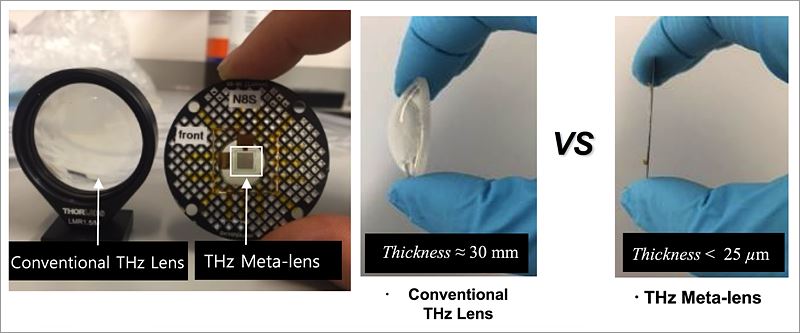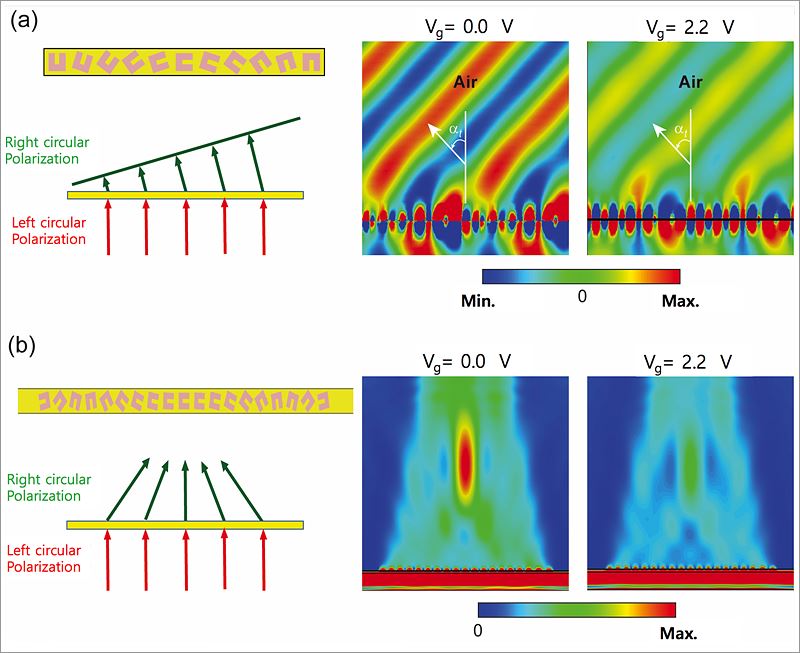mainmenu
To explore new physics phenomena of low dimensional materials
with a special emphasis on two-dimensional layered structures
[News]Ultrathin and Flat Graphene Metalenses Gain More Properties
- WriterCenter for Integrated Nanostruture Physics
- RegDate2017-11-27
- Hit10807
- att.
내용보기
On the quest for miniaturization, scientists at the Center for Integrated Nanostructure Physics, within the Institute for Basic Science (IBS, South Korea), in collaboration with researchers from the University of Birmingham and the Korea Advanced Institute of Science and Technology (KAIST), develop credit card-thick, flat lenses with tunable features. These optical devices, made of graphene and a punctured gold surface, could become optical components for advanced applications, such as amplitude tunable lenses, lasers (i.e. vortex phase plates), and dynamic holography.
Metasurfaces are new 2D materials that can effectively control the electric and magnetic components of light (and other electromagnetic waves) and bend them to bespoken directions. Controlling the beam’s direction can bring out interesting phenomena; the most incredible being the “invisibility cloak effect”, where light waves bypass an object recreating the image beyond the object, as flowing water in a river would bypass a stone.

▲ Figure 1Comparison between conventional lenses and metalenses for terahertz (THz) radiation. Metalenses are ultrathin (around 25 micrometers in thickness) and also very flat compared with conventional ones.
Published in Advanced Optical Materials, the study presents the properties of a metasurface which works as a convex lens. Specifically, it is made of a gold sheet pierced with micrometer-sized U-shaped holes and covered with graphene. As the shape of common convex lenses allows light to be concentrated on a spot (or focus), think about a magnifying glass which can concentrate a light beam and even start a fire, so the particular pattern of the tiny apertures of the metalenses works by focusing the incoming beam.
In addition, these microholes can also change light polarization. While natural light is generally unpolarized before being reflected, the team used circularly polarized waves, that is a light beam where the direction of the electric field is corkscrew spiraling. This metalens can convert the left-circular polarization wave (going counterclockwise if seen straight in front) to right-circular polarization (clockwise). The researchers managed to obtain a conversion rate of 35%. Converting circular polarization could be useful in a number of fields, for example biosensing and telecommunications.

▲ Figure 2Metalenses’ features. a) The metalenses are made with an atom-thick graphene sheet and a gold thin surface with tiny U-shaped holes. b) The device can convert the circular polarization of the erahertz wave from left to right. Moreover, by rotating the holes' pattern, the beam (or wave) can be bent it to the desired angle.

▲ Figure 3The function of the U-shaped pattern and graphene is to concentrate the beam’s direction and modulate signal intensity. Different U-shaped hole pattern on the metasurface create a striped (a) and a focalized (b) beam output. In b) the beam is concentrated to a small area (red spot), in the same way as a magnifying glass focuses light on a specific point. Moreover, by applying a gated voltage (2.2 V) on graphene, the output beam intensity becomes weaker. Graphene function could be compared to the exposure of a camera.
In order to control even more properties, the scientists took advantage of graphene’s unique electronic features and used them to tune the output beam’s intensity or amplitude. Here graphene plays the role of the exposure of a camera. In the case of the camera, a mechanical control allows a certain shutter’s opening time and size to determine the amount of light entering the instrument. These metalenses instead, regulate the exposure via an electric tension applied to the graphene sheet, without the need for bulky components. When voltage is applied to the graphene layer, the output beam becomes weaker. “Using metalenses, you can make microscopes, cameras, and tools used in very sensitive optical measurements, much more compact,” clarifies Teun-Teun Kim, the first author of the study.
The metalenses were designed for a type of electromagnetic wave, which falls in-between infrared radiation and microwave radiation, called terahertz radiation. This type of radiation can pass through some materials (like fabrics and plastics), but at a shorter depth than microwave radiation, for this reason it is employed for surveillance and security screening.
“While conventional optical lenses have a thickness of several centimeters to several millimeters, this metalens is just a few tens of micrometers thick. The intensity of the focused light can be effectively controlled and it could find useful applications in ultra-small optical instruments,” highlights the scientists.Teun-Teun Kim, the first author of the study.
Letizia Diamante
Notes for editors
- References
Teun-Teun Kim, Hyunjun Kim, Mitchell Kenney, Hyun Sung Park, Hyeon-Don Kim, Bumki Min, and Shuang Zhang. Amplitude Modulation of Anomalous Refractive Terahertz Waves with Gated-Graphene Metasurfaces. Advanced Optical Materials (2017). DOI: 10.1002/adom.201700507.
- Media Contact
For further information or to request media assistance, please contact: Mr. Shi Bo Shim, Head of Department of Communications, Institute for Basic Science (+82-42-878-8189, sibo@ibs.re.kr); Mr. Jung Gyu Kim, Global Officer, Department of Communications, Institute for Basic Science (+82-42-878-8172, jungkki1@ibs.re.kr); or Dr. Letizia Diamante, Science Writer and Visual Producer (+82-42-878-8260, letizia@ibs.re.kr).
- About the Institute for Basic Science (IBS)
IBS was founded in 2011 by the government of the Republic of Korea with the sole purpose of driving forward the development of basic science in South Korea. IBS has launched 28 research centers as of January 2017. There are nine physics, one mathematics, six chemistry, eight life science, one earth science and three interdisciplinary research centers.










